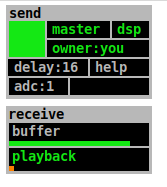evil

evil transmits live audio input to all connected clients. On the receiving
end, audio is played back with a pre-defined delay so that audio input
is musically aligned to the other instruments.
Usage
For each loaded instance of evil, there can only be one client acting as
sender, while the transmitted stream is received by all clients, the
sender included. For becoming a sender, three conditions need to be met:
- master (the master clock) needs be running
- DSP needs to be turned on
- ownership needs to be assigned to the sending client
You can claim ownership by clicking owner in the gui. Once those conditions
are met, the transmit button (top left square) turns from black to dark green
to indicated readiness. Sending audio starts as soon as the transmit button is
pressed. A receiving stream is indicated by the green buffer progress bar
filling up. The orange playback bar displays the audio level of the received
audio. As long as the transmit button is green, the stream is running. The
streaming is stopped by clicking the trasmit button again.
Some notes
Bandwidth
evil transmits one channel as 16bit PCM at Pd's current sampling rate. This
amounts to roughly 100kB/s at 44.1kHz each way.
Congestion control
evil makes sure that all clients receive the stream in time. If one client
experiences a buffer underrun, it notifies the sender instance, which then
immediately stops transmitting. If transmission keeps stopping often soon
after start, this could mean that at least one client doesn't have enough
bandwidth for evil to work properly. It could also mean that one client's
clock is ahead in time. Make sure that all participating client's master
is in sync.
Correct timing
evil tries to start playback exactly aligned to the generated instruments,
offset by the delay in the delay parameter*. This only works correctly, if
the effective round-trip audio latency is configured correctly in
